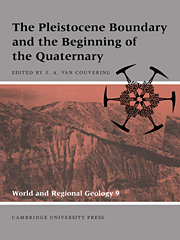Book contents
- Frontmatter
- Contents
- List of contributors
- Preface: the new Pleistocene
- Foreword
- Part I Definition of the base of the Quaternary
- Part II Characterization of the Pleistocene boundary-stratotype
- Part III The paleontological context of the Pleistocene boundary
- Part IV The Pleistocene boundary in regional sequences
- 11 The Pliocene–Pleistocene boundary in Italy
- 12 Stratigraphy of the Plio–Pleistocene sequence of the Mediterranean coastal belt of Israel and its implications for the evolution of the Nile Cone
- 13 The Pliocene–Pleistocene transition in the Iberian Peninsula
- 14 Biostratigraphy and calibrated climatic chronology of the Upper Pliocene and Lower Pleistocene of France
- 15 The Plio–Pleistocene of England and Iceland
- 16 The Neogene–Ouaternary boundary in The Netherlands
- 17 The Tertiary–Quaternary boundary in western Germany
- 18 The Pliocene–Pleistocene boundary in eastern Germany
- 19 The Plio–Pleistocene of Hungary
- 20 The Pliocene–Pleistocene boundary in Romania
- 21 The Pliocene and Pleistocene of the European part of the Commonwealth of Independent States
- 22 The N/Q boundary in Asian Russia and Tadjikistan
- 23 The Pliocene–Pleistocene boundary in the Indian subcontinent
- 24 The Pliocene–Pleistocene boundary in Japan: the Osaka Group, Kinki district
- 25 The Pliocene–Pleistocene boundary in Japan: stratigraphy in the Boso Peninsula, central Japan
- 26 The base of the Quaternary in China
- 27 Plio–Pleistocene deposits and the Quaternary boundary in sub-Saharan Africa
- 28 Plio–Pleistocene reference sections in Indonesia
- 29 The Pliocene–Pleistocene boundary in New Zealand
- 30 The Pliocene–Pleistocene boundary in continental sequences of North America
- Index
13 - The Pliocene–Pleistocene transition in the Iberian Peninsula
Published online by Cambridge University Press: 10 November 2009
- Frontmatter
- Contents
- List of contributors
- Preface: the new Pleistocene
- Foreword
- Part I Definition of the base of the Quaternary
- Part II Characterization of the Pleistocene boundary-stratotype
- Part III The paleontological context of the Pleistocene boundary
- Part IV The Pleistocene boundary in regional sequences
- 11 The Pliocene–Pleistocene boundary in Italy
- 12 Stratigraphy of the Plio–Pleistocene sequence of the Mediterranean coastal belt of Israel and its implications for the evolution of the Nile Cone
- 13 The Pliocene–Pleistocene transition in the Iberian Peninsula
- 14 Biostratigraphy and calibrated climatic chronology of the Upper Pliocene and Lower Pleistocene of France
- 15 The Plio–Pleistocene of England and Iceland
- 16 The Neogene–Ouaternary boundary in The Netherlands
- 17 The Tertiary–Quaternary boundary in western Germany
- 18 The Pliocene–Pleistocene boundary in eastern Germany
- 19 The Plio–Pleistocene of Hungary
- 20 The Pliocene–Pleistocene boundary in Romania
- 21 The Pliocene and Pleistocene of the European part of the Commonwealth of Independent States
- 22 The N/Q boundary in Asian Russia and Tadjikistan
- 23 The Pliocene–Pleistocene boundary in the Indian subcontinent
- 24 The Pliocene–Pleistocene boundary in Japan: the Osaka Group, Kinki district
- 25 The Pliocene–Pleistocene boundary in Japan: stratigraphy in the Boso Peninsula, central Japan
- 26 The base of the Quaternary in China
- 27 Plio–Pleistocene deposits and the Quaternary boundary in sub-Saharan Africa
- 28 Plio–Pleistocene reference sections in Indonesia
- 29 The Pliocene–Pleistocene boundary in New Zealand
- 30 The Pliocene–Pleistocene boundary in continental sequences of North America
- Index
Summary
Introduction
The transition from the late Neogene to the Pleistocene in the Iberian Peninsula was characterized by widespread erosion on the Meseta and its margins because of structural deformation associated with subsidence over wide areas, both along the Mediterranean shorelands and in the intramontane basins along the Betic front. Marine deposition was rare and was restricted to littoral fringes. Volcanic activity in the southeast, and also in the southern Meseta, decreased after the end of the Miocene. The paleomagnetic record is extremely limited. However, there are significant sites in continental environments with both small and large vertebrates (Figure 13.1) that provide the material for interregional correlations.
Stratigraphic sequences
Bay of Cádiz
The Bay of Cádiz, in the area between the Guadalquivir depression and the western margin of the Subbetic realm, was first inundated during the late Miocene Tortonian transgression. The subsidence of the bay was related to the advance of the Subbetic olistostrome to the north-northwest, and its present configuration was influenced by a normal fault along an east-northeast axis.
Torre del Puerco section. This section (36°19′20″N; 2°29′45″W) begins with marls and marly limestones of the TP-1 (Torre Puerco Unit 1) containing Globorotalia margaritae, overlain by TP-2 marly sands and bioturbated offshore horizons with G. crassaformis. Near its top, G. margaritae, G. crassaformis, and Turborotalia puncticulata disappear, but Globigerinoides extremus and Turborotalia humerosa are still present. The TP-3 shallow conglomerates that close this cycle yield abundant rhodoliths of Lithotamniaeae, with Flabellipecten planomedius, Pseudoamussium calcatur, Pecten jacobaeus, and Ostrea lamellosa. The top of the series is continentally karstified, and it disconformably underlies a lower to early middle Pleistocene terrace with Olduwan-like pebble tools.
- Type
- Chapter
- Information
- The Pleistocene Boundary and the Beginning of the Quaternary , pp. 169 - 177Publisher: Cambridge University PressPrint publication year: 1996
- 1
- Cited by



